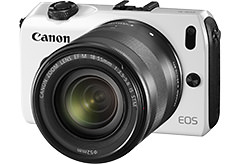Lesson 4 explains the three points for enhancing the "bokeh" effect, which we have learned in the previous lesson. If you intend to start using a mirrorless camera, or have just purchased a new camera, this series of articles provide easy-to-understand lessons on techniques for capturing charming photos using the EOS M, which boasts high image quality and yet is simple to operate even by beginners. By learning the basics of cameras and photos, you will be able to produce the shots you desire with ease! (Photos by: Takeshi Akaogi, Written & Organized by: Camera Biyori Editorial Department)

Q: How to create a stronger bokeh effect?
A: The distance between the subject and the background as well as the choice of lens are important considerations to create a larger bokeh effect.
Point 1: Focus / Get as near to the closest focusing distance as possible
The closest distance at which focus can be established is called the closest focusing distance. It is the distance from the image sensor to the subject, and varies across lenses. The closer you are to the subject, the larger will be the blurring in the area before and after the point in focus.

Closest focusing distance: 25cm

Measured from this "Φ(focal plane)" mark
Point 2: Distance / Increasing the distance between the subject and the background
Focus is established on a plane of the subject (= distance from the lens) (refer to Lesson 2) . One characteristic is that the greater the distance from the focused subject, the larger will be the effect of the background blur.
Point 3: Lens / Challenge using prime lenses!
The smaller the aperture value (f-number) of the lens, the greater will be the bokeh effect in the resulting photo. The smallest aperture value is referred to as the maximum aperture. Many prime lenses, which are simple in structure, come with small aperture values.


Let's try! Taking photos with large "bokeh" effects!
Here are some sample shots with focus established on each of the following subjects: (1) lamp; (2) back cover of a book in the foreground; (3) bird; and (4) red fruits of the tree near the center. Blurring the background significantly helps you to convey the portion you wish to bring out.

(1)

(2)

(3)

(4)

Canon's first mirrorless camera, the EOS M, comes in four color variations (black, red, white, and silver) so you can pick one according to your preference.

As a photographer, Akaogi works mainly for magazines and writes books introducing photography and practical tips. He also teaches at photography workshops.
http://www.flipphoto.org

Camera Biyori is a Japanese photography magazine introducing charming photos and daily joy with cameras. Suggesting fun activities relating to cameras and photography, Camera Biyori editorial department also offer the "Camera Biyori Photography School" to recommend its readers to engage in photography and have fun.
Published by Daiichi Progress Inc.

































